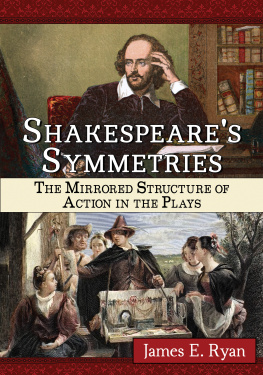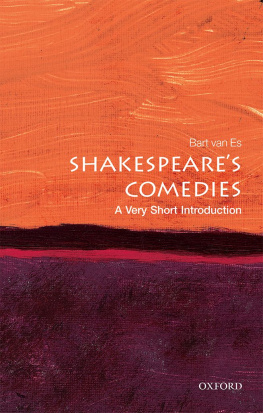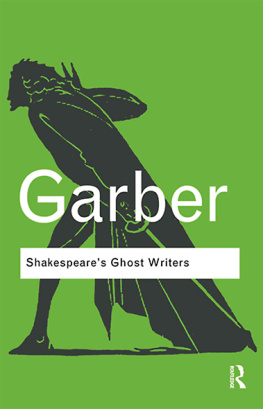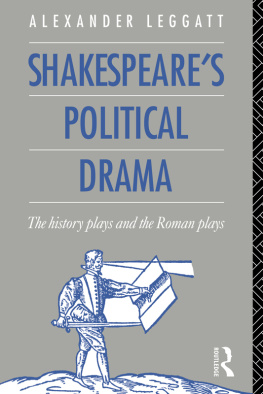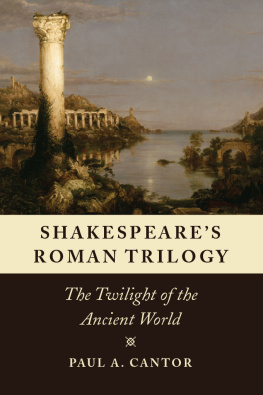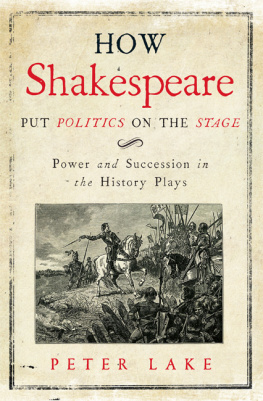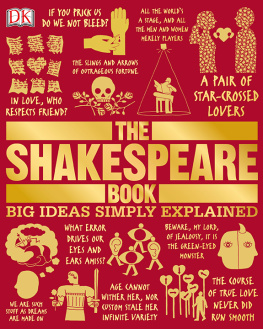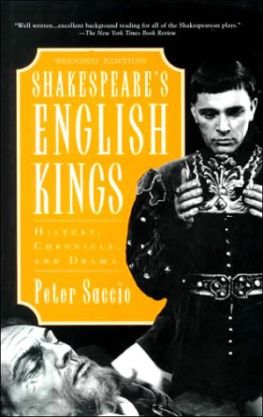
Shakespeares Symmetries
The Mirrored Structure of Action in the Plays
James E. Ryan

McFarland & Company, Inc., Publishers
Jefferson, North Carolina
LIBRARY OF CONGRESS CATALOGUING DATA ARE AVAILABLE
BRITISH LIBRARY CATALOGUING DATA ARE AVAILABLE
e-ISBN: 978-1-4766-2416-7
2016 James E. Ryan. All rights reserved
No part of this book may be reproduced or transmitted in any form or by any means, electronic or mechanical, including photocopying or recording, or by any information storage and retrieval system, without permission in writing from the publisher.
Front cover image of William Shakespeare and The Winters Tale 2016 duncan1890/iStock
McFarland & Company, Inc., Publishers
Box 611, Jefferson, North Carolina 28640
www.mcfarlandpub.com
To Christine
Preface
My original title for this book was Shakespeares Action: The Chiastic Design of the Plays. Chiastic was judged too unfamiliar to appear in the title, though it is retained in the text and thus requires some clarification. According to the Oxford English Dictionary, chiasmus is derived from a Greek word meaning crossing, a diagonal arrangement, esp. of clauses of a sentence. Hence, the definition: a grammatical arrangement by which the order of words in one of two parallel clauses is inverted in the other: Fair is foul, and foul is fair (Macbeth); I wasted time and now doth time waste me (Richard III). In recent criticism, particularly of the Bible, the term chiasmus is not limited to the grammatical arrangement of words but is applied to larger structures of inverse parallelism as well, such as the narrative design of Exodus (ABCDXDCBA). It is in this larger sense that I deploy the term throughout this book, more or less interchangeably with terms like symmetrical structure or mirroring actions. I do not, however, extend the term so far as to leave behind specific repeated elements, such as individual actions or characters, that confirm the pattern. We might say of King John, for example, that it has an X-shaped, or chiastic, pattern similar to that in Richard II: like Richard, King John declines; like Bolingbroke, the Bastard rises (Braunmuller, 72). But this use of the term, untethered as it is from details of the play, provides only an impression of the overall action and serves little analytical purpose.
My original title was intended to emphasize what I take to be a neglected aspect of Shakespeares art, his action. Though drama is, in substance and etymology, action, Shakespeares language receives far more attention than his equally brilliant and subtle plot and character actions. Surely, our greatest dramatist must be a connoisseur of action, and his resonant language must be in the service of that essential element, the very stuff of any play. Shakespeares perfect hold on the Aristotelian action, in Una Fermor-Elliss phrase, allows a more nuanced presentation of action than is usually appreciated. The final transformation of, say, Antoniothe action of his reformin The Merchant of Venice is completed in a single line; and Gobbos service to Bassanio in the same play is echoed, amplified and judged by Portias analogous disguised service at the trial. Furthermore, some actions crucial to the meaning of a play as so finely threaded through the narrative as to be nearly invisible; the six analogous meals in Othello, traced in a later chapter, are an especially elusive instance. Shakespeares actions warrant closer attention than they have so far received.
My original main title was also intended to hint at the action of Shakespeare himself in constructing the plays. Our ignorance of the playwrights constructive practice is implicitly lamented by John Jones: Antony and Cleopatra and The Tempest [are masterpieces] about the making of which almost nothing can be inferred. If some purchase could be gained from the inside upon just these two very disparate works, our impression of the creative process in Shakespeare might be significantly different, and it would certainly be richer (38). It is exactly some purchase from the inside, not just of these two plays but of the entire mature canon, that the analysis of Shakespeares symmetrical structures provides.
This book, then, isolates and interprets the chiastic designs structuring Shakespeares mature, non-collaborative plays. It demonstrates that essential thematic elements, usually actions, are disposed in a reflecting pattern, ABCBA, in all the mature plays, and that this pattern is foundational for the narrative, the imagery and other dramatic elements. It is this pattern, for example, not the usual considerations of cleared stage or continuous action, that explains the scene designations in Folio Measure for Measure and other Folio plays whose scene breaks are routinely changed by modern editors; the chiastic design determines Shakespeares scene divisions. Furthermore, once shown to be invariable, Shakespeares structural chiasmus becomes a predictive tool, as any departure from it must be, to whatever extent, non-Shakespearean. As every play has an unrepeated central element and thus an odd number of scenes, the 24-scene Quarto Lear, for example, could never have been intended to be a final form of the play, as some critics and editors have maintained. Nor could the central, keystone scene of 2 Henry IV, missing from the earliest Quarto, have been part of an extensive revision to the play; it must have been an overlooked sheet of the original composition. In some cases the chiastic design also illuminates plays whose structures have long been disparaged. The badly proportioned King John, the peculiarly uncertain structure of The Merry Wives of Windsor, and the Antony and Cleopatra that bewilders the mind are seen to be thematically organized, rigorously crafted and surprisingly unified. Finally, by heightening unnoticed reflections and structural rhythms, the chiastic design often reveals subtleties otherwise invisible.
I have most often referred to the chiastic design as an arch, the most convenient (and historically appropriate) rendering of the symmetry of Shakespeares thematic patterns. They can be likened to, say, Gothic portals with keystones and historiated columns, the sculptures on each side reflecting Old and New Testament figures as Shakespeare mirrors essential actions in the first and second halves of his plays. This thematic arch is not to be confused with the well-known Freytag triangle, which is a largely metaphorical tool of narrative analysis. Even the terms used to describe parts of a playexposition, rising action, climax, denouementare inextricably sequential, their meanings determined by what precedes or follows in the play. That is, a play is treated as a dramatized narrative only, with no other unifying structure, no other possible patterning of its plot. Of course, Shakespeares myriad other patternsof imagery, character, dramatic situation, stage action, etc.are the very stuff engaging most criticism. But these patterns are confluences of meaning rather than structural configurations with a definite periodicity. To posit a pattern of food imagery in Much Ado About Nothing, say, is not to claim a spatial relationship between the individual images. Nor does the Freytag triangle claim anything more than a rough figurative approximation of the movement of a plays conflicts, whereas the chiastic thematic arch is a precisely mirroring structure of identical and contrasting actions.
Next page
